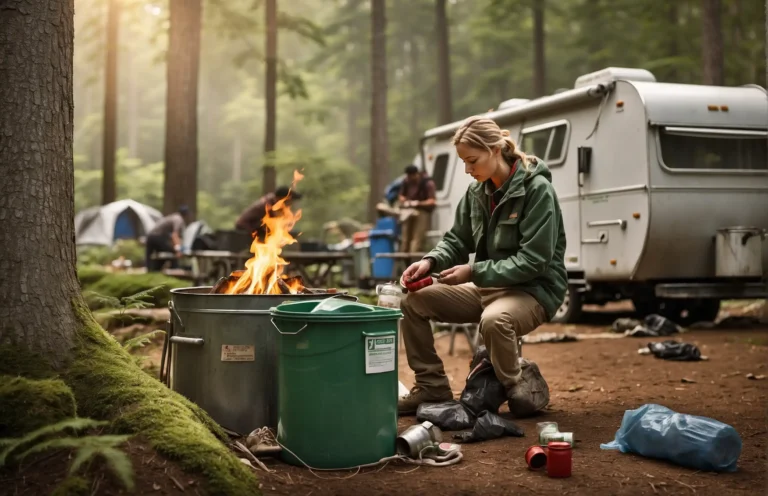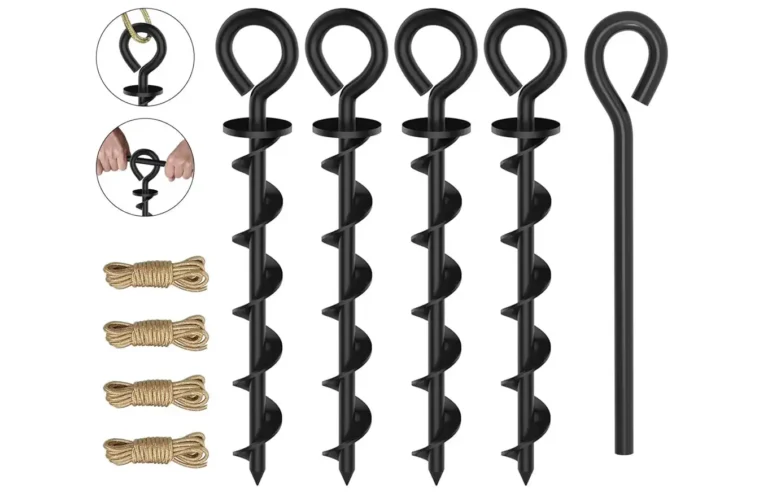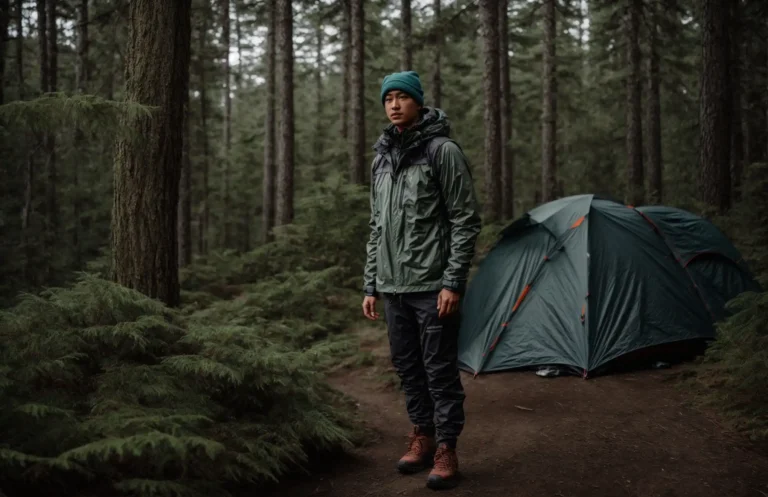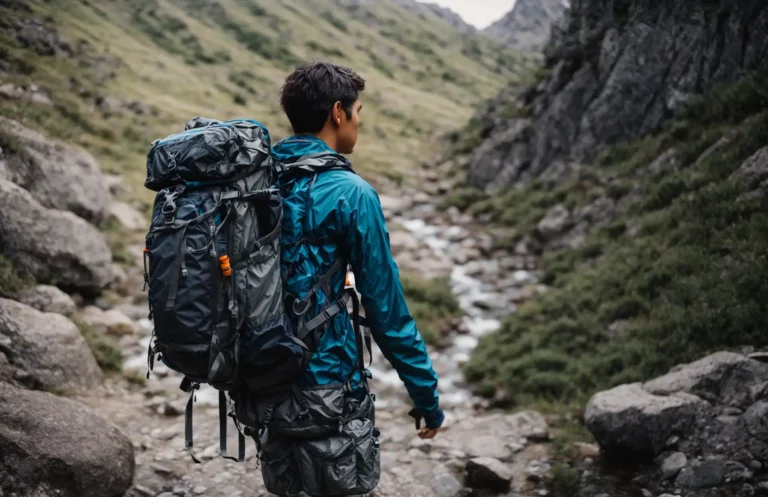To keep bedding dry when camping, use a waterproof tent and an elevated sleeping platform. Ensure all equipment is dry before setting up camp.
Camping offers a refreshing escape into nature, but damp bedding can quickly dampen spirits. Seasoned and novice campers alike prioritize a dry sleeping space to ensure comfort and warmth throughout the night. Staying dry is not just about comfort; it also prevents the growth of mold and mildew, which can damage gear and health.
This guide outlines essential steps to protect your bedding from the elements, incorporating practical tips and simple strategies. By choosing the right equipment and employing smart camping practices, you can create a cozy, dry retreat even in the great outdoors. With the right preparation, you can enjoy the wilderness without the worry of waking up to a soggy sleeping bag.
Introduction to Dry Bedding and Camping Comfort
A successful camping trip hinges on a good night’s sleep, and dry bedding is a key component of that equation. Whether you’re settling down under the stars after a day of hiking or unwinding by a campfire, the comfort of your camping bed can make or break your outdoor experience. Understanding the dynamics of keeping your sleeping area dry is not just about comfort, but also about health, as dampness can lead to hypothermia and spoil your adventure.
The Importance of Staying Dry for a Good Night’s Sleep
Ensuring dry bedding while camping is vital for multiple reasons. Firstly, it prevents the growth of mold and mildew that thrive in moist environments. Secondly, a dry sleeping environment maintains your body heat, essential for a restful night’s sleep, especially in colder climates. Lastly, a dry bed ensures comfort and hygiene, keeping you energized and ready for the next day’s activities.
Overview of Challenges Faced in Keeping Bedding Dry While Camping
Campers face several obstacles when it comes to maintaining dry bedding. These challenges include:
- Unexpected weather conditions like rain or heavy dew
- Condensation inside tents due to temperature differences
- Ground moisture seeping through tent floors
- Wet clothing or gear brought inside the sleeping area
Tackling these hindrances requires knowledge and the right gear. From choosing the correct campsite to using waterproof materials and understanding ventilation, campers need to arm themselves with both strategies and equipment to ensure their bedding stays dry throughout the night.
Preparation: Setting the Foundation For Dry Bedding
Preparation for camping starts with a pivotal step – ensuring a good night’s sleep. One crucial aspect of this is maintaining dry bedding throughout the trip, as dampness not only discomforts but also poses health risks. Proper preparation sets a solid foundation for keeping your sleeping quarters moisture-free. With attention to detail in three key areas, you can create an optimal sleeping environment, regardless of the weather conditions.
Selecting the Right Campsite to Prevent Moisture Issues
The location of your campsite is a determining factor in your battle against dampness. Here’s how to strategically choose your spot:
- Avoid low-lying areas and valleys where water naturally collects. Look for slightly elevated ground to prevent rainwater from becoming an unwelcome guest.
- Distance from water bodies matters. Lakes, ponds, and rivers can contribute to a damp microclimate. Ensure you set up camp at a reasonable distance.
- Consider natural wind barriers such as bushes or trees but be cautious not to camp directly under large trees that can drip sap or moisture onto your tent.
Choosing Weather-appropriate Camping Gear
Investing in the right gear is synonymous with camping success. When it comes to bedding, making the right choices can mean the difference between a cozy sleep and a soggy nightmare. Follow these guidelines:
- Opt for a high-quality, weather-rated tent with a robust rainfly that covers all sides.
- Select sleeping bags specifically designed for the season – insulating and waterproof options for winter, lighter, breathable materials for summer.
- Avoid cotton and opt for synthetic or wool materials for your bedding, as they still provide insulation even when wet.
Waterproofing Essentials: Sprays and Protective Covers
Proactive measures to waterproof your gear will reinforce dryness. Here’s a quick guide on safeguarding your bedding:
| Waterproofing Tool | Description | Application |
|---|---|---|
| Waterproof Sprays | Sealant sprays designed for tent exteriors, rainflies, and gear | Apply as directed before the trip and allow to dry completely |
| Tarpaulins | Durable sheets placed under or over tents for extra protection | Secure beneath the tent to avoid water seepage or above as an additional rainfly |
| Protective Covers | Covers for sleeping bags and mattresses | Use nightly to shield against dew and moisture in the air |
Additional reinforcements such as dry bags keep clothing and spare bedding away from moisture. Opt for bags with a high waterproof rating and a secure sealing mechanism.
Learn: What to Bring Camping in a Cabin
The Role of Tents and Shelters
Keeping your bedding dry while camping is crucial for a comfortable and safe outdoor adventure. The first line of defense against the elements is your choice of shelter. Tents and alternative shelters are designed to provide protection from moisture, but using them effectively requires some know-how. Explore tent features, setup tips, and additional shelter options to ensure a dry camping experience.
Understanding Tent Features That Keep Out Moisture
Modern tents are equipped with a variety of features to repel water and maintain interior dryness. Key elements include:
- Waterproof Ratings: Look for tents with high hydrostatic head ratings, indicating better waterproof capabilities.
- Seam Taping: Sealed seams prevent water from seeping through stitch lines.
- Rainfly: An ample-sized rainfly extends beyond the tent base, directing rain away.
- Bathtub Floor: This design feature curves the tent floor up along the sides, minimizing ground moisture seepage.
Setting Up Tents: Tips to Ensure Proper Ventilation and Dryness
Proper tent setup is fundamental for a dry interior. Follow these tips:
- Choose the Right Spot: Set up on elevated ground to avoid water pooling.
- Use a Footprint: A footprint under the tent adds an extra moisture barrier.
- Optimize Rainfly Tension: A taut rainfly allows water to run off quickly.
- Maintain Adequate Ventilation: Open vents to reduce condensation buildup inside the tent.
Additional Shelters: Using Tarps and Bivouac Sacks For Extra Protection
For enhanced moisture defense, consider these additions:
- Tarps: Position above or below your tent for another layer of protection.
- Bivouac Sacks: Also known as bivy sacks, they offer a waterproof enclosure around your sleeping bag.
Integrating these strategies, your camping trip remains comfortably dry, come rain or shine.
Bedding Choices and Maintenance
An outdoor adventure often includes delightful days and enchanting nights under the stars. But, ensuring a good night’s sleep involves keeping your bedding dry amidst the varying weather conditions that camping brings. The choices you make for your sleep setup and the maintenance of your bedding are pivotal for comfort and warmth. Dive into ways to select the right materials and maintain them properly for a dry, cozy rest in the great outdoors.
Selecting Bedding Materials Designed For Moisture Resistance
Water-resistant and quick-drying fabrics reign supreme in outdoor bedding choices. Always opt for synthetic fibers like polyester or nylon, which not only repel moisture but also provide longevity and durability. Consider specially-designed outdoor blankets and sleeping bags that often come with a Durable Water Repellent (DWR) coating to prevent moisture penetration. For additional warmth, a fleece liner can be a game-changer as it not only adds a layer of insulation but also wicks away moisture from the body.
- Synthetic Sleeping Bags: Ideal for repelling water and retaining warmth even when damp.
- Water-Resistant Down: Treated down that offers better moisture resistance than traditional down.
- Bivouac Sacks (Bivy): An extra layer that shields your sleeping bag from moisture.
Daily Maintenance of Bedding: Airing Out and Drying Techniques
Ensuring your bedding stays dry doesn’t stop at material choice; daily upkeep is key. Start by shaking out your sleeping bag or blankets to get rid of any internal moisture or condensation each morning. If the sun graces you with its presence, take advantage of the natural drying power by spreading your bedding out in a sunny spot for a few hours. For those overcast days, find a wind-protected area to allow air to circulate around the bedding. Should anything feel damp at bedtime, use microfiber towels to blot away excess moisture before snuggling in.
- Shake and Fluff: Begin each day by aerating your sleeping bag and blankets to prevent moisture build-up.
- Solar Drying: Utilize sunny spots near your campsite to dry bedding during the day.
- Wind Airing: Allow air to circulate by hanging bedding in a breeze.
- Towel Drying: Pat down any dampness with a microfiber towel for immediate moisture absorption.
Utilizing Sleeping Pads and Liners For Added Moisture Barriers
Avoid direct contact between your bedding and the tent floor by using sleeping pads. These pads act as critical barriers, not only providing comfort from the hard ground but also insulating your sleeping space from ground moisture. Closed-cell foam pads are particularly effective as they don’t absorb water. In addition, sleeping bag liners can be used to shield the inside of your sleeping bag from moisture, all while offering the added bonus of keeping your bag cleaner for longer.
- Closed-Cell Foam Pads: A non-absorbent option that provides excellent protection from ground moisture.
- Inflatable Sleeping Pads: Typically have a waterproof surface and offer additional comfort.
- Sleeping Bag Liners: Protect the interior of your sleeping bag and can be easily removed and dried.
Dealing With Humidity and Unexpected Rain
Embarking on a camping adventure brings excitement and a close connection with nature, but dealing with weather unpredictabilities such as humidity and unexpected rain can dampen spirits, quite literally. Keeping your bedding dry is essential for a comfortable night’s sleep and maintaining a healthy tent environment. With proper preparation and knowledge of emergency measures, even the most unforeseen downpour won’t ruin your outdoor experience. Let’s explore how to counter the challenges of humidity and rain and keep that bedding dry and toasty!
Managing Humidity Inside the Tent for Optimal Comfort
Maintaining a comfortable level of humidity inside your tent is key to ensuring dry bedding throughout the night. Here are some tips to manage indoor moisture:
- Ventilation: Always utilize your tent’s built-in ventilation features, such as vents or airflows, to allow moist air to escape.
- Absorb Moisture: Use moisture-absorbing products like silica gel packets strategically placed around the tent.
- Avoid Brining in Wet Gear: Keep wet clothing and gear outside or in a designated wet area to prevent additional moisture from entering the sleeping space.
Emergency Measures: What To Do When Rain Soaks Through
Sometimes, despite your best efforts, rain finds its way into your tent. Don’t panic. Immediate action can prevent total bedding saturation:
- Tarp Cover: If you haven’t already, quickly throw a waterproof tarp over your tent to provide an additional barrier against the rain.
- Relocate: Move your bedding away from tent walls and any area where water may pool or drip inside the tent.
- Water Collection: Place containers to collect dripping water and mitigate spreading moisture.
Drying and Recovering Wet Bedding: Practical Tips and Tricks
Even when bedding gets wet, all is not lost. Drying and recovering your sleeping gear is possible with a few savvy moves:
| Action | Benefit |
|---|---|
| Use Microfiber Towels: | They absorb large amounts of water quickly; dab your bedding gently to remove excess moisture. |
| Air Dry: | Whenever the rain stops, spread out your bedding to air dry; sunlight is an excellent antibacterial agent. |
| Portable Fans: | Battery-powered fans can help circulate air and speed up the drying process. |
Remember, diligence in preparation and quick response to weather changes can make all the difference. By managing humidity and having a plan for unexpected rain, you’ll be able to keep your bedding dry and enjoy the adventures that await in the great outdoors.
Conclusion
Embracing these tips ensures your camping experience remains cozy and dry. Short, actionable advice, like choosing waterproof materials and utilizing ground cover, enhances your outdoor sleep quality. Share this guide with fellow adventurers and gear up for a blissful, dry night under the stars.
Craving more camping knowledge? Our Learning space at Outdoor Awaits is packed with information just for you. Stick around for more! Happy camping!






